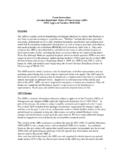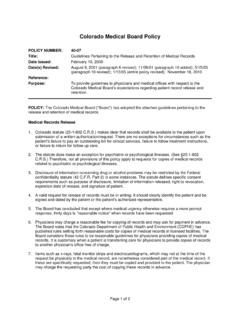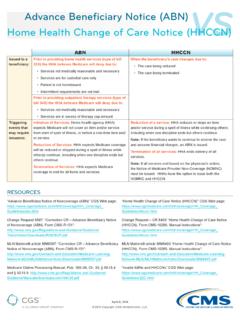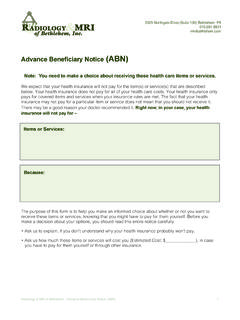Transcription of Form Instructions Advance Beneficiary Notice of …
1 1 form Instructions Advance Beneficiary Notice of Noncoverage (ABN) OMB Approval Number: 0938-0566 Overview The ABN is a Notice given to beneficiaries in Original Medicare to convey that Medicare is not likely to provide coverage in a specific case. Notifiers include physicians, providers (including institutional providers like outpatient hospitals), practitioners and suppliers paid under Part B (including independent laboratories), as well as hospice providers and religious non-medical health care institutions (RNHCIs) paid exclusively under Part A. They must complete the ABN as described below, and deliver the Notice to affected beneficiaries or their representative before providing the items or services that are the subject of the Notice . (Note that although Medicare inpatient hospitals and home health agencies (HHAs) use other approved notices for this purpose, skilled nursing facilities (SNFs) must use the revised ABN for Part B items and services.)
2 Beginning March 1, 2009, the ABN-G and ABN-L will no longer be valid; and notifiers must begin using the revised Advance Beneficiary Notice of Noncoverage (CMS-R-131). The ABN must be verbally reviewed with the Beneficiary or his/her representative and any questions raised during that review must be answered before it is signed. The ABN must be delivered far enough in Advance that the Beneficiary or representative has time to consider the options and make an informed choice. Employees or subcontractors of the notifier may deliver the ABN. ABNs are never required in emergency or urgent care situations. Once all blanks are completed and the form is signed, a copy is given to the Beneficiary or representative. In all cases, the notifier must retain the original Notice on file. ABN Changes The ABN is a formal information collection subject to approval by the Executive Office of Management and Budget (OMB) under the Paperwork Reduction Act of 1995 (PRA).
3 As part of this process, the Notice is subject to public comment and re-approval every 3 years. The revised ABN included in this package incorporates: suggestions for changes made by notifiers over the past 3 years of use, refinements made to similar liability notices in the same period based on consumer testing and other means, as well as related Medicare policy changes and clarifications occurring in the same interval. We have made additional changes based on suggestions received during the recent public comment period. This version of the ABN continues to combine the general ABN (ABN-G) and the laboratory ABN (ABN-L) into a single Notice , with an identical OMB form number. As combined, however, the new Notice will capture the overall improvements incorporated into the revised ABN while still permitting pre-printing of the lab-specific key information and denial reasons used in the current ABN-L. Also, note that while previously the ABN was only required for denial reasons recognized under section 1879 of the Act, the revised version of the ABN may also be used to provide 2 voluntary notification of financial liability.
4 Thus, this version of the ABN should eliminate any widespread need for the Notice of Exclusion from Medicare Benefits (NEMB) in voluntary notification situations. Instructions for completion of the form are set forth below. Once the new ABN approval process is completed, CMS will issue detailed Instructions on the use of the ABN in its on-line Medicare Claims Processing Manual, Publication 100-04, Chapter 30, 50. Related policy on billing and coding of claims, as well as coverage determinations, is found elsewhere in the CMS manual system or website ( ). Completing the Notice OMB-approved ABNs are placed on the CMS website at: . Notices placed on this site can be downloaded and should be used as is, as the ABN is a standardized OMB-approved Notice . However, some allowance for customization of format is allowed as mentioned for those choosing to integrate the ABN into other automated business processes. In addition to the generic ABN, CMS will also provide alternate versions, including a version illustrating laboratory-specific use of the Notice .
5 ABNs must be reproduced on a single page. The page may be either letter or legal-size, with additional space allowed for each blank needing completion when a legal-size page is used. Sections and Blanks: There are 10 blanks for completion in this Notice , labeled from (A) through (J), with accompanying Instructions for each blank below. We recommend that the labels for the blanks be removed before use. Blanks (A)-(F) and blank (H) may be completed prior to delivering the Notice , as appropriate. Entries in the blanks may be typed or hand-written, but should be large enough ( , approximately 12-point font) to allow ease in reading. (Note that 10 point font can be used in blanks when detailed information must be given and is otherwise difficult to fit in the allowed space.) The Option Box, Blank (G), must be completed by the Beneficiary or his/her representative. Blank (I) should be a cursive signature, with printed annotation if needed in order to be understood.
6 A. Header Blanks A-C, the header of the Notice , must be completed by the notifier prior to delivering the ABN. Blank (A) Notifier(s): Notifiers must place their name, address, and telephone number (including TTY number when needed) at the top of the Notice . This information may be incorporated into a notifier s logo at the top of the Notice by typing, hand-writing, pre-printing, using a label or other means. 3 If the billing and notifying entities are not the same, the name of more than one entity may be given in the Header as long as it is specified in the Additional Information (H) section who should be contacted for questions. Blank (B) Patient Name: Notifiers must enter the first and last name of the Beneficiary receiving the Notice , and a middle initial should also be used if there is one on the Beneficiary s Medicare (HICN) card. The ABN will not be invalidated by a misspelling or missing initial, as long as the Beneficiary or representative recognizes the name listed on the Notice as that of the Beneficiary .
7 Blank (C) Identification Number: Use of this field is optional. Notifiers may enter an identification number for the Beneficiary that helps to link the Notice with a related claim. The absence of an identification number does not invalidate the ABN. An internal filing number created by the notifier, such as a medical record number, may be used. Medicare numbers (HICNs) or Social Security numbers must not appear on the Notice . B. Body Blank (D): The following descriptors may be used in the header of Blank (D): Item Service Laboratory test Test Procedure Care Equipment The notifier must list the specific items or services believed to be noncovered under the header of Blank (D). In the case of partial denials, notifiers must list in Blank (D) the excess component(s) of the item or service for which denial is expected. For repetitive or continuous noncovered care, notifiers must specify the frequency and/or duration of the item or service.
8 See for additional information. General descriptions of specifically grouped supplies are permitted. For example, wound care supplies would be a sufficient description of a group of items used to provide this care. An itemized list of each supply is generally not required. When a reduction in service occurs, notifiers must provide enough additional information so that the Beneficiary understands the nature of the reduction. For example, entering wound care supplies decreased from weekly to monthly would be appropriate to describe a decrease in frequency for this category of supplies; just writing wound care supplies decreased is insufficient. Blank (E) Reason Medicare May Not Pay: In this blank, notifiers must explain, in Beneficiary friendly language, why they believe the items or services described in Blank (D) may not be covered by Medicare. Three commonly used reasons for noncoverage are: 4 Medicare does not pay for this test for your condition.
9 Medicare does not pay for this test as often as this (denied as too frequent). Medicare does not pay for experimental or research use tests. To be a valid ABN, there must be at least one reason applicable to each item or service listed in Blank (D). The same reason for noncoverage may be applied to multiple items in Blank (D). Blank (F) Estimated Cost: Notifiers must complete Blank (F) to ensure the Beneficiary has all available information to make an informed decision about whether or not to obtain potentially noncovered services. Notifiers must make a good faith effort to insert a reasonable estimate for all of the items or services listed in Blank (D). In general, we would expect that the estimate should be within $100 or 25% of the actual costs, whichever is greater; however, an estimate that exceeds the actual cost substantially would generally still be acceptable, since the Beneficiary would not be harmed if the actual costs were less than predicted.
10 Thus, examples of acceptable estimates would include, but not be limited to, the following: For a service that costs $250 : Any dollar estimate equal to or greater than $150 Between $150-300 No more than $500 For a service that costs $500: Any dollar estimate equal to or greater than $375 Between $400-600 No more than $700 Multiple items or services that are routinely grouped can be bundled into a single cost estimate. For example, a single cost estimate can be given for a group of laboratory tests, such as a basic metabolic panel (BMP). Average daily cost estimates are also permissible for long term or complex projections. As noted above, providers may also pre-print a menu of items or services in Blank (D) and include a cost estimate alongside each item or service. If a situation involves the possibility of additional tests or procedures (such as in reflex testing), and the costs associated with such tests cannot be reasonably estimated by the notifier at the time of ABN delivery, the notifier may enter the initial cost estimate and indicate the possibility of further testing.









![[HOME] [ABOUT US] [THE SURROGATE] [PROBATE] …](/cache/preview/9/9/4/9/a/2/2/e/thumb-9949a22ea74d124ecdeba7399ac10967.jpg)